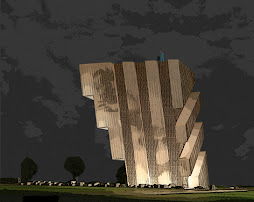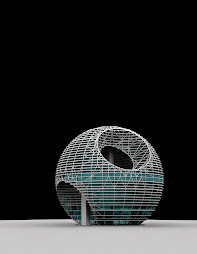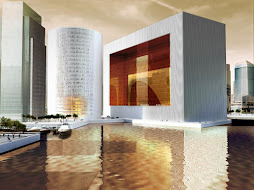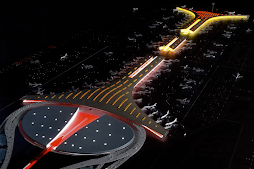 Beijing International Airport, Beijing
Beijing International Airport, BeijingFoster & Partners. Under construction, to be completed in late 2007
According to the U.S. Embassy to China, the country will be building 108 new airports between 2004 and 2009 -- including what will be the world's largest: the Beijing International Airport, designed by Foster & Partners. Set to open at the end of 2007, in time for the Beijing Olympics in 2008, the airport terminal will cover more than 1 million square meters, giving it a bigger footprint than the Pentagon. It's designed to handle 43 million passengers a year initially and 55 million by 2015, figures that will probably push the new facility into the ranks of the top 10 busiest airports, going by the 2004 numbers from the Airports Council International. Given the scale and traffic, Foster & Partners focused on the traveler's experience, making sure that walking distances are short, for instance.
 Shanghai World Financial Center, Shanghai
Shanghai World Financial Center, ShanghaiKohn Pedersen Fox Architects. Under construction, completion scheduled for 2008
Rising in the Lujiazhui financial district in Pudong, the Shanghai World Financial Center is a tower among towers. The elegant 101-story skyscraper will be (for a moment, at least) the world's tallest when completed in early 2008. One of the biggest challenges of building tall is creating a structure that can withstand high winds. The architects devised an innovation solution to alleviate wind pressure by adding a rectangular cut-out at the building's apex. Not only does the open area help reduce the building's sway but it also will be home to the world's highest outdoor observation deck -- a 100th-floor vista that will take vertigo to new heights.
 National Swimming Center, Beijing
National Swimming Center, Beijing PTW and Ove Arup. Under construction, completion scheduled for 2008
 Central Chinese Television CCTV, Beijing
Central Chinese Television CCTV, Beijing OMA/Ole Scheeren and Rem Koolhaas. Under construction, scheduled for completion in 2008
The design of the new Central Chinese Television (CCTV) headquarters defies the popular conception of a skyscraper -- and it broke Beijing's building codes and required approval by a special review panel. The standard systems for engineering gravity and lateral loads in buildings didn't apply to the CCTV building, which is formed by two leaning towers, each bent 90 degrees at the top and bottom to form a continuous loop.
The engineer's solution is to create a structural "tube" of diagonal supports. The irregular pattern of this "diagrid" system reflects the distribution of forces across the tube's surface. Designed by Rem Koolhaas and Ole Scheeren and engineered by Ove Arup, the new CCTV tower rethinks what a skyscraper can be.
Herzog & de Meuron. Under construction, to be completed in 2008
 National Grand Theater, Beijing
National Grand Theater, Beijing Paul Andreu and ADP. Under construction, to be completed in 2008
French architect Paul Andreu is no stranger to controversy -- or to innovative forms. A generation ago, in 1974, his untraditional design for Terminal 1 of Paris's Charles de Gaulle airport was criticized for its unusual curves, yet Andreu's groundbreaking, futuristic building later was seen to distinguish de Gaulle from more generic European and international air hubs. (The same airport's Terminal 2E, also designed by Andreu, gained attention in 2004 when it collapsed, tragically killing four people.)


















No comments:
Post a Comment